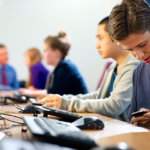 The tendency to multi-task, and therefore not absorb ourselves in the task at hand is one of the most common accusations to be labelled at the Internet, with digital distractions only a cat video away. How does this impact our ability to learn? That was the question posed by a recent study from Kent State University, which set out to explore whether students multitask more in an online learning environment than they do face-to-face.
The tendency to multi-task, and therefore not absorb ourselves in the task at hand is one of the most common accusations to be labelled at the Internet, with digital distractions only a cat video away. How does this impact our ability to learn? That was the question posed by a recent study from Kent State University, which set out to explore whether students multitask more in an online learning environment than they do face-to-face.
Such a question is especially important as the growth in online learning has accelerated rapidly in recent years. If such online courses are to be effective, it’s vital that students are able to focus without being distracted by the various attractions available online.
“This question is important to ask because an abundance of research demonstrates that multitasking during educational activities significantly reduces learning,” the researchers say.
Driven to distraction
The researchers quizzed a few hundred students who had recently completed an online module as part of their college course, as well as a traditional face-to-face module at the same college. The students were asked how often they tended to multitask during each module, whilst also gauging the students’ preference for multitasking and their confidence in their ability to regulate the behavior.
The data found that, perhaps unsurprisingly, multitasking was found to be far more common when students studied online than in a physical setting. Interestingly however, whilst those with a predilection for multitasking seemed to fulfil that desire when studying online, they abstained when studying face-to-face.
“This is likely because in face-to-face courses, a physically present teacher and the presence of conscientious students help to enforce classroom policies and behavioral norms against multitasking,” the researchers say.
Self-control
The ability to self-regulate was also a factor, as students who were confident in their ability to do so managed to exert this control when in a face-to-face environment, especially compared to their peers who were not so confident. This tended to melt away once those students were on the online course however, with the temptation proving too great.
“This suggests that how we teach students to self-regulate for learning applies well to traditional face-to-face courses, but perhaps it does not apply well to online learning,” the authors explain. “Because multitasking during educational activities has a negative impact on learning, it is important to develop methods for reducing this academically disadvantageous behavior, particularly in the increasingly common online learning environment.”
Just as with things like the marshmallow test, the authors suggest the key to better self-regulation is to put all temptations and possible distractions away when we’re learning. The more this becomes habitual, the easier it becomes, and they suggest we can even try it during leisure activities. For instance, if we’re watching television, remove our phones to avoid the temptation to message friends.
We might also use our environment to help us. For instance, we could do the learning in a library where the cultural norms of the environment already discourage distractions.
“Additionally, as universities increase their online course offerings, even for students already living on or near campus, these same universities might consider computer labs dedicated to online learning that are proctored in an effort to keep students on task,” the authors conclude.